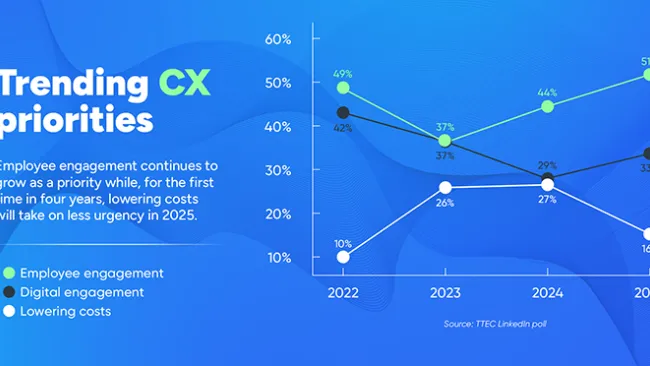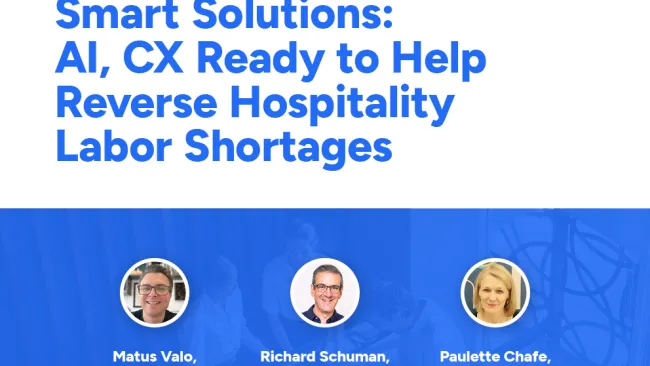In the face of the Great Resignation, industries across every sector are faced with a harsh reality: give your employees a healthy and productive work environment or they will leave you. And the contact center industry is not exempt.
With several outsourcing contact centers in 2021 reporting training class rates as low as 20% and above average stress levels, it’s no longer a question of how does the industry recruit quality employees, but how does it retain them?
Meeting employee needs and equipping them with the right tools with be critical in 2022. In order to foster and retain talent, here are 4 strategies that can used to create a healthier and more cost-effective contact center environment.
1. Put employee needs on top
The nature of work has changed, but human needs haven’t: technology alone isn’t going to retain your employees, a better and livable wage will.
Your associates are the front line of your business. They are your brand ambassadors who interact with your customers every day. They can make or break customer loyalty and influence revenues, costs, and overall corporate financial health.
If you treat employees as valuable assets with higher pay and a more supportive work environment, you will attract better quality associates, they will stay longer, and they will provide better service. In the long run they will cost you less than if you pay lower wages because they will stay longer and improve their skills over time.
The average wage for a U.S. contact center representative is $14.64 per hour, according to Indeed. In our experience, we have found that even slight increases above market averages will attract better candidates who will be more likely to stay, both in the U.S. and elsewhere. Associate tenure increases, which leads to a range of other performance and customer KPIs.
We see that investing up front in talent is the most efficient way to simultaneously improve your customer experience and your bottom line. Attrition is a profitability killer. If you can stem attrition, you can fund the pay increases easily.
2. Balance automation with humanity
In the years before the pandemic, analysts knew that the adoption of AI, machine learning, and automated interactions were rapidly on the rise, but little did we know how essential these innovations would be in the new-normal. In the summer of 2020, a Harris Poll indicated that 92 percent of business leaders agree that survival post-pandemic includes enabling digital channels and automation in the workplace.
We have reached the tipping point from automation as hype to business-as-usual. The need for rapid information on vaccinations, employment, and government mandates has skyrocketed the need for self-service and deflection to help manage volume surge.
Automation and customer self-service tools can ease the human burden for supporting repeatable, simple, transactional interactions. This will be incredibly important in the upcoming months as vaccine registration cites face overwhelming demands and overcrowding. Give your associates the tools they need for interactions that are complicated, highly valuable, and emotionally driven. The goal is to create “do no harm” automation policies and processes that free up human resources to focus on higher-value interactions. It can’t just be a cost savings decision.
3. Unlock insights with analytics
When margins are tight, the ability to gather insights about associates early on about their future potential is a critical asset. Double this by the fact that our now remote work environment has increased the talent pool to a global level.
From talent acquisition through the employee lifecycle, data-driven insights can fuel employee performance, satisfaction, and retention throughout the associate hiring, training, and development lifecycle. And having happy, knowledgeable, invested employees more easily translates into increased customer satisfaction. Both historical and predictive insight can enhance a company’s ability to create productive, engaged workers.
For example, in the recruitment phase, talent acquisition leaders can determine the most predictive pre-hire characteristics of future employees, based on common attributes of their most successful associates, such as education and high levels of empathy. In the training and development phases, employee or trainer performance metrics can be analyzed to find positive and negative outliers in performance during training and in live environments. The curriculum can be modified based on performance and on how effective the methods are in both training and the live environment.
And retention analysis can help companies focus on the rewards or recognition associates enjoy most (bonuses, days off, longer breaks, control over schedule); who is likely to attrite and when; and where there are training gaps that hinder upward employee mobility.
4. Eliminate waste from operations
Zeroing in on inefficiencies that slow down operations and cause friction in the customer experience can help companies identify areas that constrain to their long-term growth, scalability, and ultimately profitability. The good news for companies interested in improving their operations is that even small, incremental changes can make a big difference.
Call deflection strategies help eliminate “bad volume” by reducing redundant calls or pre-empting calls with proactive outreach before a customer needs to pick up the phone. Frequent caller activity analysis can identify common issues in products, services, or customer experiences that may be fixed to prevent future calls. Simple changes to associate scripts, website text, or app tools may reduce handle time and increase resolution rates. And operational assessments can look at the entirety of the customer interaction to see what can be streamlined.
Taking it a step further, customer journey orchestration programs design, implement, and manage all the steps a customer has with your company, in various channels. Deciding which of these touchpoints can be automated, which can be streamlined, and which can be eliminated will also reduce waste in effort and money.
In 2022 great EX is a priority
Prior to the pandemic, most contact centers operated in the same factory approach they did 30 years ago, even as businesses all around them evolve to be more employee-centric.
In the face of the Great Resignation, the efficiency gained from automation, process improvements, and talent acquisition/retention must be re-invested to retain talent. There will always be a need for humanity in the customer experience space, and it begins with fostering humanity in the workplace.

















